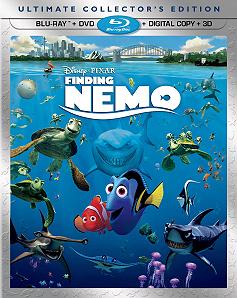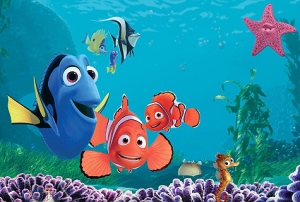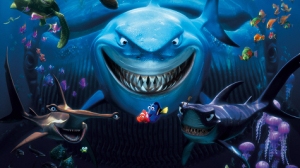Still Solid After All These Years
 Back in 2003, when Finding Nemo hit the big screen, Pixar had a track record of only four prior feature films! Having covered such topics as living toys, the day in the life of a bug, and blue-collar trials and tribulations of the average working monster, Finding Nemo represented a departure from land-based set computer wizardry to oceanic exploits of the grandest scale.
Back in 2003, when Finding Nemo hit the big screen, Pixar had a track record of only four prior feature films! Having covered such topics as living toys, the day in the life of a bug, and blue-collar trials and tribulations of the average working monster, Finding Nemo represented a departure from land-based set computer wizardry to oceanic exploits of the grandest scale.
Finding Nemo takes its viewers along on the offbeat voyage of an overprotective clownfish father, Marlin (Albert Brooks), as he attempts to locate his lost (abducted) son, Nemo (Alexander Gould). See it turns out that while defying his father, young Nemo wanders too close to a human scuba diving expedition and ends up becoming a salt-water aquarium specimen.
In an instant, the once free clown fish finds himself captive (with several other inhabitants) in the waiting room of an Australian dentist’s office. The film basically divides its time flashing between the two environments: Marlin’s trek across the ocean to reach Sidney Harbor (with the aid of a forgetful regal tang named Dory (Ellen DeGeneres) and a hippie aquatic turtle named Crush (voiced by director Andrew Stanton)) & Nemo’s time in captivity, planning a great escape.

At a runtime of 100-minutes (1 hour, 40 minutes), Finding Nemo is one of the lengthier entries into the CG feature genera; a condition further exemplified by the plot pacing, which though certainly passable, seems to harken back to an era before the Pixar gang turned the craft into a well-oiled machine.
On the surface the Finding Nemo formula is pretty simplistic, almost too linear for my own tastes but a little deeper examination reveals a pretty solid grasp of the complex relationship between a father and son; one in which all that remains of a once-thriving family (with 399 siblings) is one another.
I have actually followed along on studies that set out to prove that in each other’s absence, each of the title clown fish discover the missing element of their relationship: Marlin finds himself befriending a creature (Dory) who proves that survival is possible in the rough and tumble ocean without short term memory or even much common sense while the captive Nemo finds himself under the tutelage of a father figure (Gill) who finds no fault in continually putting Nemo in harm’s way. Without revealing too much of the film’s conclusion, the arc of the story is in fact a lesson in perfecting the relationship between parent & child.
The lighting effects and underwater setting of the film are still quite spectacular even to this day. Scripting is, as is expected of the Disney/ Pixar machine, quite polished. The humor is actually a little weak, especially when compared to the more risqué overtones made famous by prime competition DreamWorks. The Thomas Newman composition/ scoring is subliminally brilliant throughout.

It should also be noted that the influence Finding Nemo has had on the collective industry in general is undeniable. DreamWorks answered with their own underwater adventure a couple years later in Shark Tale, Weinstein Company’s The Reef would follow suit two years after that (then a sequel) and even 20th Century Fox wanted in on the action with 2010’s The Dolphin: Story of a Dreamer. Phase 4 films brought us the unwatchable Legend of the Sea, StidioCANAL released a Turtle’s Tale 1 & 2 and Lion’s Gate has Sea Level. The point is underwater CG films are very, VERY popular. Of course it could be argued that none were near as successful at delivering such a simple prose laced with such complex emotions.
In all Finding Nemo has certainly earned its place in the hallowed halls of CG feature fame despite the fact that it’s difficult for me to consider its delivery revolutionary. It does nothing worthy of complaint, make no mistake, but in my opinion nor does it excel in the arena of humor, plotting or sheer Pixar-esque cleverness.
By the way, the making-of featurette contains a segment that demonstrates Pixar’s study of real aquatic environments as so thorough that early graphic tests were “too realistic”. The appearance of the environments had to actually be cartooned for the actual production. The comparison shots here are truly so amazing as to be worth the price of admission alone. In all a very worthy addition to any collection. Interestingly at the time of this review’s republishing, a direct sequel titled Finding Dory is set to arrive to theaters in a few months.
